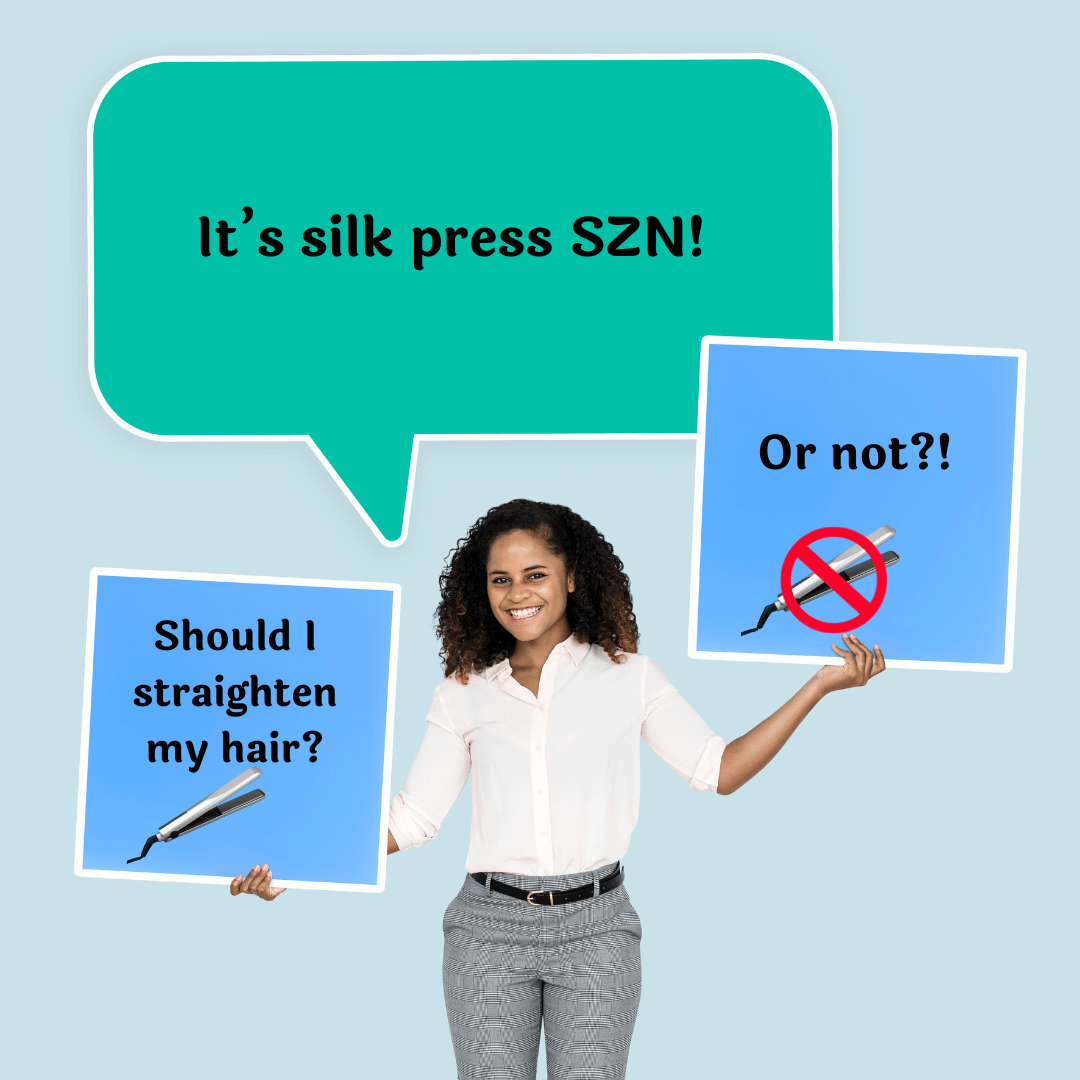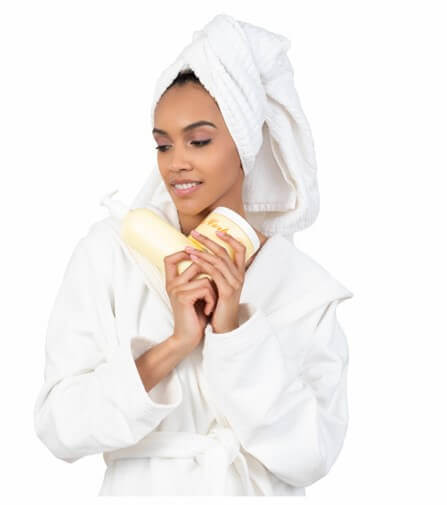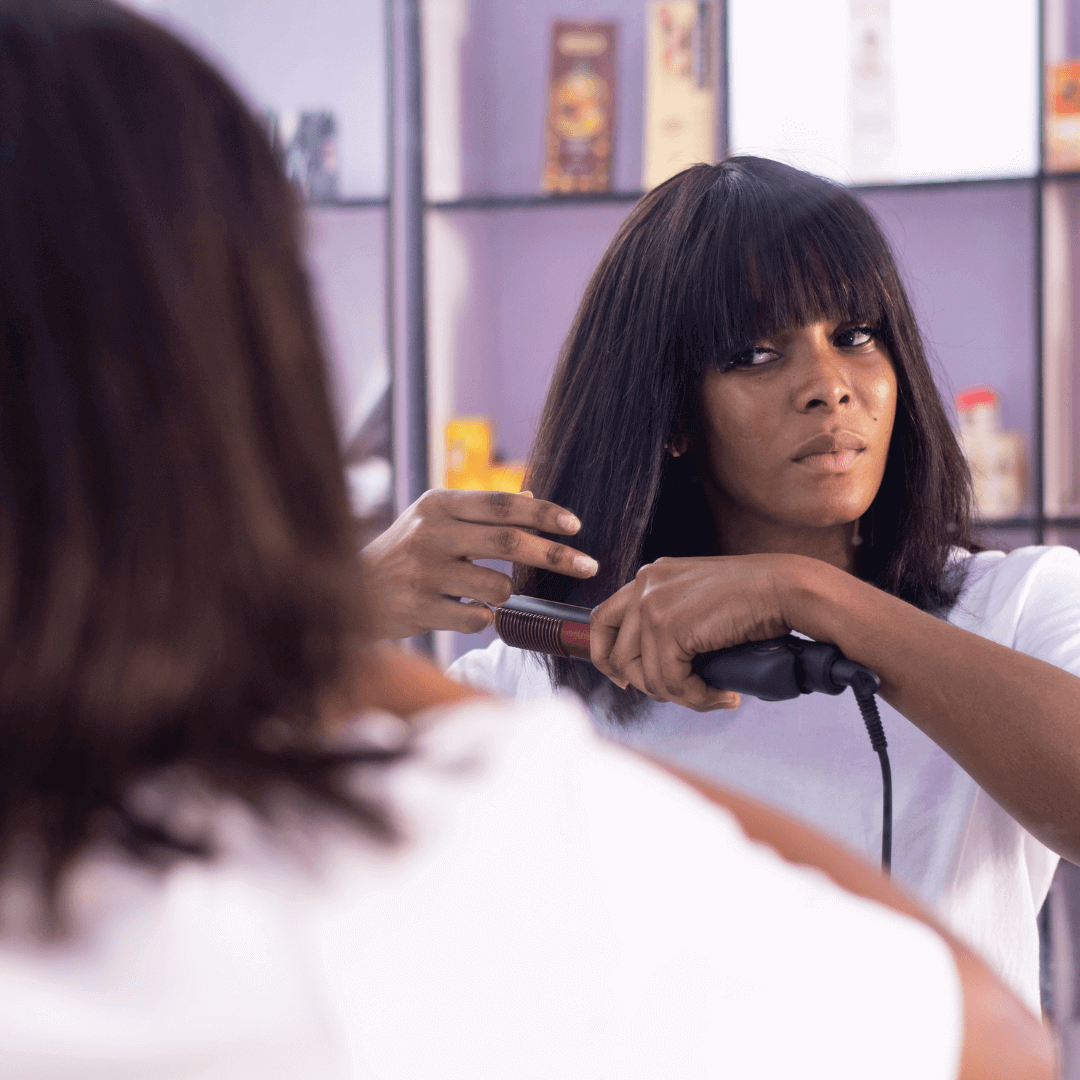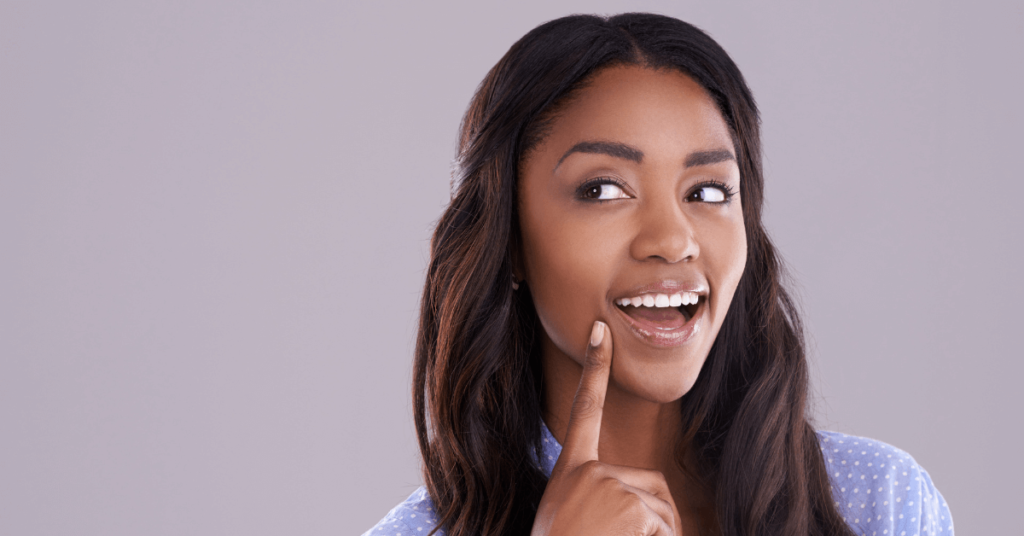Do you want to know when to flat iron your natural hair?
If you’re like me, you’ve embraced an incredible journey wearing your natural hair texture. Natural hair is a beautiful canvas of diverse textures and curl patterns, and flat ironing can be a tempting option for achieving a sleek, straight look.
Before you rush to heat up that flat iron, let’s talk about when and how to do it safely. Keeping your curls healthy and flourishing is essential! Today, we’ll explore when it’s the right time to flat iron your natural hair. Also, I’ll share some tips for achieving stunning results without compromising your hair’s integrity.
Are you ready for them? Let’s go!
Quick Question: Are you frustrated or tired of not knowing how to properly take care of your natural hair? Join our email list where we provide the best tips and tricks for your kinks, coils, and curls!
This post contains affiliate links, which means I may receive a small commission, at no cost to you, if you make a purchase through a link.
When to Flat Iron Natural Hair – Everyone Loves Tip #4
Understanding Your Natural Hair
Before we dive into the timing of flat ironing, it’s crucial to understand your hair’s needs and characteristics. Natural hair comes in various types and textures, from tightly coiled to loose waves. Take time to learn your unique hair type and its porosity. These factors play a significant role in determining when to flat iron.
Furthermore, hair density is another key factor to know for your specific hair type and whether flat ironing would be a safe option. For example, if your hair is thin or breaks easily, you might want to think about whether you should flat iron your natural hair.
The Heat Debate: Why Flat Ironing Natural Hair Can Be Risky

Flat ironing can provide a sleek and polished look, but it’s essential to acknowledge the potential risks. To put it simply, natural hair is delicate and prone to damage if not treated with care. Here are some key reasons why flat ironing natural hair can be risky.
Heat Damage: Natural hair is more vulnerable to heat damage than other hair types. Flat irons can reach high temperatures. Excessive heat can weaken the hair’s protein structure, leading to breakage, split ends, and permanent alteration of the hair’s natural curl pattern.
Loss of Moisture: Natural hair tends to be dry, and using a flat iron without proper heat protectants can further strip moisture from the hair shaft. Over time, this can result in brittle and lifeless hair.
Breakage and Split Ends: The repetitive motion of flat ironing, especially if done improperly or too frequently, can cause the hair to become brittle and prone to breakage. Split ends can also develop, which may require regular trims to maintain healthy hair.
Uneven Application: Achieving consistent results with a flat iron can be challenging, especially if you are not experienced. Uneven pressure or temperature distribution can result in sections of hair being straightened more than others, leading to an uneven appearance.
Loss of Natural Curl Pattern: Repeated flat ironing can permanently alter the natural curl pattern of natural hair, making it difficult to return to its original state without extensive hair treatments.
Once that curl pattern is compromised or lost, then it’ll be time to pull out those hair shears for a big chop! Or, if you just can’t bring yourself to a full-blown big chop, cut your hair gradually at the ends. Moreover, as your hair grows out, keep cutting until all damage is gone. You should be able to retain length as your hair grows from the root while snipping the damage.
Now that we’ve learned the risks that come with flat ironing natural hair, let’s get to the rules of doing it safely!
RELATED: 5 Ways How to Steam Natural Hair – You Won’t Believe #3
When to Flat Iron: The Golden Rules

Timing is everything when it comes to flat ironing natural hair, and everyone loves tip #4 😊 . Here are some golden rules to consider!
- Healthy Hair First: Ensure your hair is in excellent condition before flat ironing. This means maintaining a proper moisture and protein balance, as well as having regular trims to eliminate split ends.
- Minimal Frequency: Limit flat ironing to special occasions such as weddings, parties, or other formal events. Infrequent use reduces the risk of heat damage. In addition, go for a sleek look during the colder months, which leads to the next tip!
- Weather Check: Consider the weather before flat ironing. High humidity can cause your hair to revert quickly, potentially leaving you frustrated. Also, rain could wreck a flat ironed ‘do as well! This is a look that should not be saved for a rainy day 😅!
- Length Check: This is what natural hair dreams are made of! Most of us long for lengths and make it a goal to achieve them! Some people flat iron their natural hair to check their hair’s length and growth progress. You can do this every few months to track your hair’s development.
- Change of Style: If you want a change from your natural curls and prefer a straight or smoother look for a period, you can flat iron your hair. Just be mindful not to make it a regular habit.
- Protective Styling: Now, this tip here is debatable because flat ironed hair is not necessarily a protective style, but here are a few reasons to consider flat ironing as a part of a protective styling regimen:
- Reduced Manipulation: Protective styles aim to reduce the amount of manipulation and handling your hair undergoes, which can help minimize breakage and damage. When you flat iron your hair and wear it straight, you typically don’t need to comb or detangle it as frequently as you would with your natural curls. This reduced manipulation can protect your hair from mechanical damage.
- Sealed Ends: Flat ironing can help to temporarily seal the ends of your hair, preventing split ends and reducing the need for frequent trims. Split ends are a common source of hair damage, so minimizing them can contribute to healthier hair.
- Length Retention: Flat ironed hair tends to appear longer because it is straightened, which can be a plus for individuals who want to enjoy the appearance of longer hair without the need for extensions or chemical treatments. This can be particularly helpful for those who are on a journey to grow their hair.
- Low Maintenance: Compared to some other protective styles like braids or twists, flat ironed hair can be relatively low maintenance once it’s straightened. This means less daily manipulation and less friction between hair strands.
Lastly, these tips can be useful if you plan to wear your hair straight for a few weeks or months as a protective style to give your natural curls a break.
RELATED: When to Deep Condition Natural Hair – Factor #2 is Key
Preparing for the Flat Ironing Process

Now that we know when to flat iron natural hair, let’s prepare for the process!
Cleanse: Shampoo and condition your hair, then gently detangle it to minimize stress on your strands. Additionally, always shampoo your hair at least twice! Be sure to use the pads of your fingers when working the shampoo into your scalp and hair.
Deep Conditioning and Detangle: Begin with a moisturizing deep conditioning treatment on freshly washed hair to ensure that it is well-hydrated and strong. Mielle Organics Babassu Oil and Mint Conditioner can provide your hair with both protein and moisture. As you apply a conditioner, smooth it into your strands by raking it through with your fingers and detangling it. Also, you could use a wide-toothed comb or Denman brush to further detangle and distribute the conditioner through your hair.
Heat Protectant: Apply a high-quality heat protectant generously to shield your hair from the heat. I personally do not like to use products with silicone, so my go-to heat protectant is Briogeo’s Farewell Frizz Blow Dry Perfection and Heat Protectant Creme. Don’t like creme heat protectants? No problem! Opt for Mielle Organics Avocado & Tamanu Anti-Frizz Treatment for a smooth, shiny, and silky finish!
Now, I can’t give you the process without sharing some techniques!
The Flat Ironing Technique

Achieving the perfect flat-ironed look requires skill and patience. Take a look below at the most effective steps to safely straighten your hair:
Sectioning: Divide your hair into manageable sections to ensure even heat distribution and thorough straightening.
Heat Setting: Use the lowest effective heat setting to minimize the risk of damage. Higher heat isn’t always better!
Slow and Steady: Slowly glide the flat iron down each section, ensuring you don’t pass over the same area too many times to avoid overexposure to heat.
Post-Flat Iron Care

Hope you weren’t thinking that it’s over, because not so fast! The work doesn’t end after you’ve flat ironed your hair. Next, we are going to cover how to maintain your straightened style!
Nighttime Routine: Protect your style by wrapping your hair with a silk/satin scarf or using a silk/satin pillowcase.
Apply Lightweight Oils: Keep your hair shiny and flowing with a lightweight oil or serum. Straightened hair does not need a lot of products applied afterward because it could start to look weighed down and greasy. A little product goes a long way, so apply a dime-sized amount to the palm of your hand, rub them together, and smooth the oil or serum into your hair.
Avoid Repeated Heat: Limit the use of additional heat styling tools to extend the life of your flat-ironed style.
Avoid Water-Based Products: You’ll want to avoid water-based products for your flat-ironed mane because they could cause frizz and revert your straightened lengths to curls and coils.
So, there you have it!

Flat ironing natural hair can be a game-changer for switching up your look, but it’s essential to do it thoughtfully and with care. Also, keep the frequency of flat ironing to a minimum. It has been a couple of years since I’ve had my hair flat ironed, but I would recommend getting your hair straightened at most twice a year.
Make sure to join our email list for more tips on maintaining healthy natural hair, style inspiration, and more! Become a part of the community today!
You Might Also Like:
